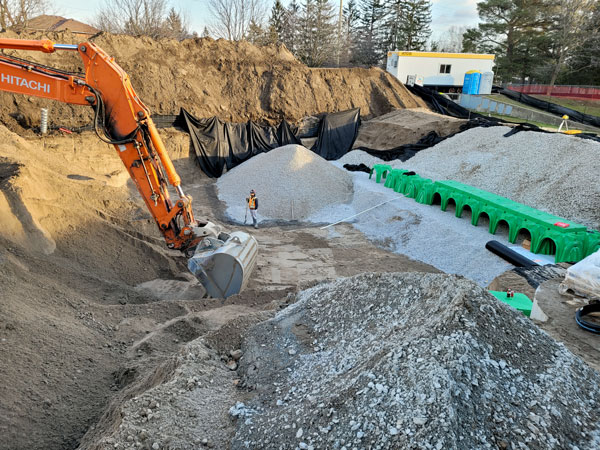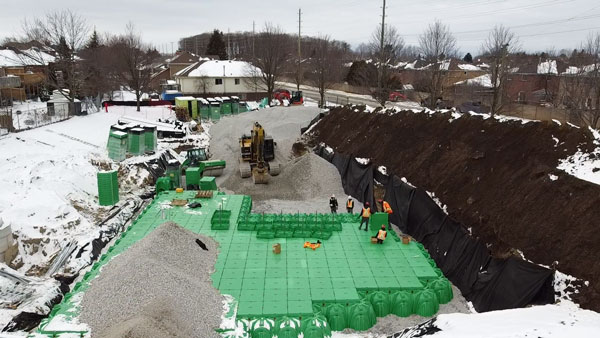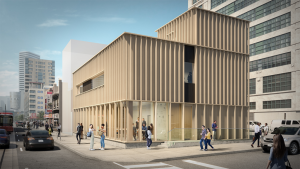Another project in a series of pro-active initiatives to protect the health of Lake Simcoe, the fourth largest lake wholly within Ontario and a major tourist destination, is nearing completion in Barrie, Ont.
Designed by Aquafor Beech Limited, the joint City of Barrie/Lake Simcoe Region Conservation Authority undertaking is a $1.6-million retrofit of the Irwin storm management pond in the Kidd’s Creek watershed in the northwest corner of the city.
Construction started in the fall of 2021. The general contractor is the Greenspace Group and the equipment supplier is Terrafix.
Once the retrofitted pond is fully back online, it will significantly decrease the amount of stormwater entering into the creek—which flows into Lake Simcoe, as well reducing the amount of phosphorous loading into the lake by 58 per cent.
Those environmental objectives will be attained through the first-ever installation of the Triton Stormwater Vault System in a storm management pond in Canada.
Although that system and comparable ones have been placed under parks, parking lots and other sites, “this is the first time it had been used underneath a municipal stormwater management pond in Canada,” says the City of Barrie’s engineering project manager, Jeff Henry.
Buried just 0.5-metres below the pond bottom and underlined with clear stone which will provide additional runoff storage and infiltration, the segmented vault system is comprised of 450 modules which look like a series of large Lego blocks. Inserted by hand by the contractor, they were locked together with a top cap which allows them to become one unit, he says.

1/3
CITY OF BARRIE — Progress of the installation.
2/3
CITY OF BARRIE — Aerial view of the site. The low flow channel, flow splitter and berm are visible in the foreground and oil grit separator units and vault system in the background.
3/3
CITY OF BARRIE — Progression of the vault installation.
The modules are basically holding tanks which allow stormwater to seep naturally into the ground. After entering the pond, stormwater will be diverted into a twin unit oil/grit separator, which will remove oil, debris, and other suspended solids, and then piped into the vault system.
In periods of extremely heavy rainfall storms, an outlet channel will direct water into a storm drain which extends to Kidd’s Creek.
But the whole purpose and intent of the one-metre-high vault system is to curtail that detrimental impact. The storage capacity of the pond will have been increased from its current 5,640-cubic-metre capacity to just over 8,000 cubic metres, he says.
Irwin Pond is a dry pond, says Henry, explaining that during prolonged non-rainy periods it’s dry and only fills with water—and then slowly releases into the watershed—when it does rain.
“That (the dry condition) has made it easier for construction. But this was a difficult site and there was no room to store materials,” says Henry, in referring to the pond’s location off of Sunnidale Road and immediately adjacent a residential area.
Although the work was confined to the pond’s original footprint, approximately 2,050 cubic metres of topsoil and earth had to be removed. After the vault system was installed, about 320 cubic materials of that material were reused to cover it.
As the site is quite small, Greenspace utilized a limited number of machines including excavators and mini excavators. However, the construction didn’t generate any dust or impact traffic on Sunnidale Road and the nearby homeowners understood the need for the project, he says.
A vital component of the construction was the building of a berm between the active excavation and the existing low flow channel to protect the work area from the stormwater inflows. It was part of the construction sequencing and in accordance with the project erosion and sediment control plan.
Later this spring the berm will be removed and the site restored with landscaping for a scheduled project completion date of early June, he says.
A 2001 master drainage plan first identified the need for the project and that need was subsequently confirmed in a second plan in 2018. Design work started that same year.
The City of Barrie is leading the project, while the Lake Simcoe Region Conservation Authority has been providing technical advice, as well as funding through its Phosphorous and Water Balance Offset Funding Program, says Henry.
Irwin Pond’s is technically known as the Sunnidale SWMF KD03, as it’s the third pond draining into the Kidd’s Creek watershed. The city is considering installing the Triton system at one of those other ponds, as well incorporating similar systems at other ponds around Barrie, he says.
The project is a “great example” of the partnerships which have been forged between municipalities and the conservation authority, says its chief administrative officer, Rob Baldwin.
“We know our watershed will experience higher than average annual temperature increases and expect to see more frequent and intense rainfall events and the possibility of more widespread flooding events,” says Baldwin, in emphasizing the need for projects such as the Irwin pond retrofit.
A number of other projects are also in the works for 2022, he says.
“We’re currently developing a blueprint to improve stormwater management within the East Holland River sub watershed. Once completed, it may formulate the basis of a watershed-wide approach to managing stormwater.”
Several other restoration projects are planned for this year with two in Barrie, one of which is another stormwater pond retrofit to help improve the health of the Sophia Creek, says Baldwin.











Recent Comments
comments for this post are closed